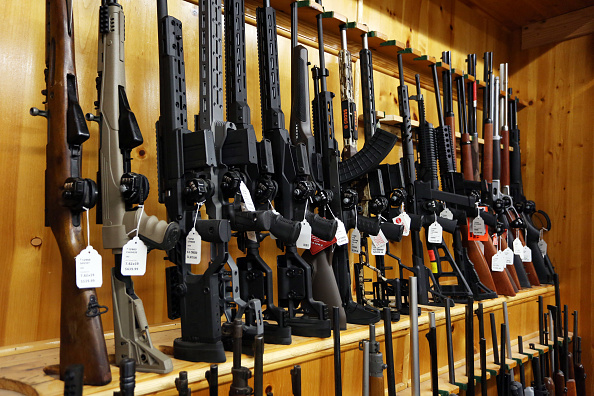
Rifles are on display at a hunting store on June 3, 2022 in Ottawa. (Photo by Dave Chan / AFP via Getty Images)
By
Ottawa has proposed the launch of its nationwide gun buyback program to start in Prince Edward Island, according to a memo from the federal procurement department.
Released by Public Services and Procurement Canada (PSPC) on Dec. 29, the memo describes the “transition” of how firearms will be confiscated from gun owners in the country’s smallest province, which according to the memo, has already commenced in December.
“Prince Edward Island (PE) will be used as a pilot and will be the first point of collection based on the smaller number of firearms,” said the memo, titled “2022 Minister’s Transition Book 2: Core responsibility 1—Purchase of goods and services,” as first reported by Blacklock’s Reporter.
“As a result, lessons learned, gaps analysis and risk assessment would inform the phase 2 national roll-out.”
According to the memo, phase 2 of the national roll-out is planned for spring 2023 once an information technology case management system is in place.
“It will be implemented in collaboration with other government departments, provincial, municipal and territorial governments and potential Industry partners,” the memo said.
The department acknowledged there is “very limited interest from the industry” in supporting the buyback program first proposed three years ago.
The Ban
In 2020, the Liberal government issued a ban on more than 1,500 models of previously legally purchased firearms. In October the government put a freeze on the transfer and importation of handguns, which effectively bans handgun ownership in the country.
In late November, the government tabled sweeping last-minute amendments to Bill C-21, An Act to amend certain Acts and to make certain consequential amendments (firearms), which is currently being debated by the Commons public safety committee.
If passed, the bill will ban most semi-automatic shotguns and rifles—including many ordinary hunting shotguns and rifles purchased legally. The proposed amendments would also ban any gun that can hold a detachable magazine.
“The prohibition applies to all current and future firearm variants that meet the criteria—now, over 1,800 firearms,” the memo said. “These firearms can no longer be legally used, sold, or imported.”
The Trudeau government had said in September 2019 that the gun ban and buyback would cost the country $200 million. In June 2021, the Parliamentary Budget Office (PBO) estimated that the spending could go as high as $756 million, but warned details “remain unclear.”
“There remains too many outstanding questions on how this program will be implemented to currently develop a complete picture of the true potential cost of the program,” said PBO’s “Cost Estimate of the Firearm Buyback Program” report.
The number of affected firearms ranged widely from 150,000 (data obtained from the federal government) to as many as 518,000 (data from the Canadian Sporting Arms and Ammunition Association), the report added.
“The primary intent of the buyback program would be to safely buyback these now prohibited firearms from society, while offering fair compensation to businesses and lawful owners impacted by the prohibition,” said the PSPC’s memo.
“PSPC is currently examining options for implementation of the buyback program, including the potential of contracting out specific activities.”
Push Back
The Liberals’ gun buyback program receives strong push back from several provinces.
On Dec. 15, Alberta’s Justice Minister Tyler Shandro wrote a letter to federal Justice Minister David Lametti, informing that the province is taking back jurisdiction on the handling of gun-related charges from Ottawa.
“Albertans should not automatically be considered criminals because they own a firearm that was legally purchased and possessed,” said Shandro in a news release on the same day.
“This new protocol for [Alberta’s Crown] prosecutors will help prevent otherwise law-abiding individuals from facing criminal charges and potential time in jail. At the same time, law enforcement and prosecution resources can be prioritized for actual violent and repeat offenders while not further clogging our already busy courts.”
The Saskatchewan government likewise introduced The Saskatchewan Firearms Act to “protect the rights of lawful firearms owners” on Dec. 1.
“This Act will help address concerns of responsible firearms owners and enhance public safety across Saskatchewan,” said the province’s Corrections, Policing and Public Safety Minister Christine Tell in a news release. “We take public safety seriously and support initiatives that reduce the criminal use of firearms, while preventing gang violence and stopping illegal guns from entering our province.”
On Nov. 24, the two provinces, together with Manitoba, issued a joint release, to oppose the federal government’s last-minute amendments to Bill C-21, which will further “criminalize hunters, farmers and target shooters.”
In October, New Brunswick joined forces with the Prairie Provinces in opposing the use of police for Ottawa’s gun confiscation program. The Yukon Legislative Assembly also passed a motion against the measures in the same month.
Should the national roll-out be implemented, the RCMP’s “2020 Commissioner of Firearms Report” estimated that 6,464 licensed gun owners in Prince Edward Island will be affected.
The figure is comparably smaller than those in larger provinces: Ontario (624,448), Quebec (486,406), Alberta (328,723), British Columbia (315,077), Saskatchewan (112,790), Manitoba (93,182), Newfoundland and Labrador (75,957), Nova Scotia (75,501), New Brunswick (70,425).
Licensed gun owners that will be impacted in the Yukon, Northwest Territories, and Nunavut, numbered 8,056, 5,961, and 3,765, respectively.
Marnie Cathcart and Peter Wilson contributed to this report.